Tour and Travel Industry: Changes and Impact
VerifiedAdded on 2020/10/23
|11
|3088
|426
AI Summary
The tour and travel industry has undergone significant changes from the 19th to 21st century. Initially started by Thomas Cook in 1822, the industry faced revolutions and transformations due to external factors like economic, environmental, and non-economic conditions of the country. After World War II, technological advancements, globalization, product development, and other changes impacted the industry, shifting its pattern from supply to demand-driven. The assignment examines these transformations and their effects on the tour and travel sector.
Contribute Materials
Your contribution can guide someone’s learning journey. Share your
documents today.
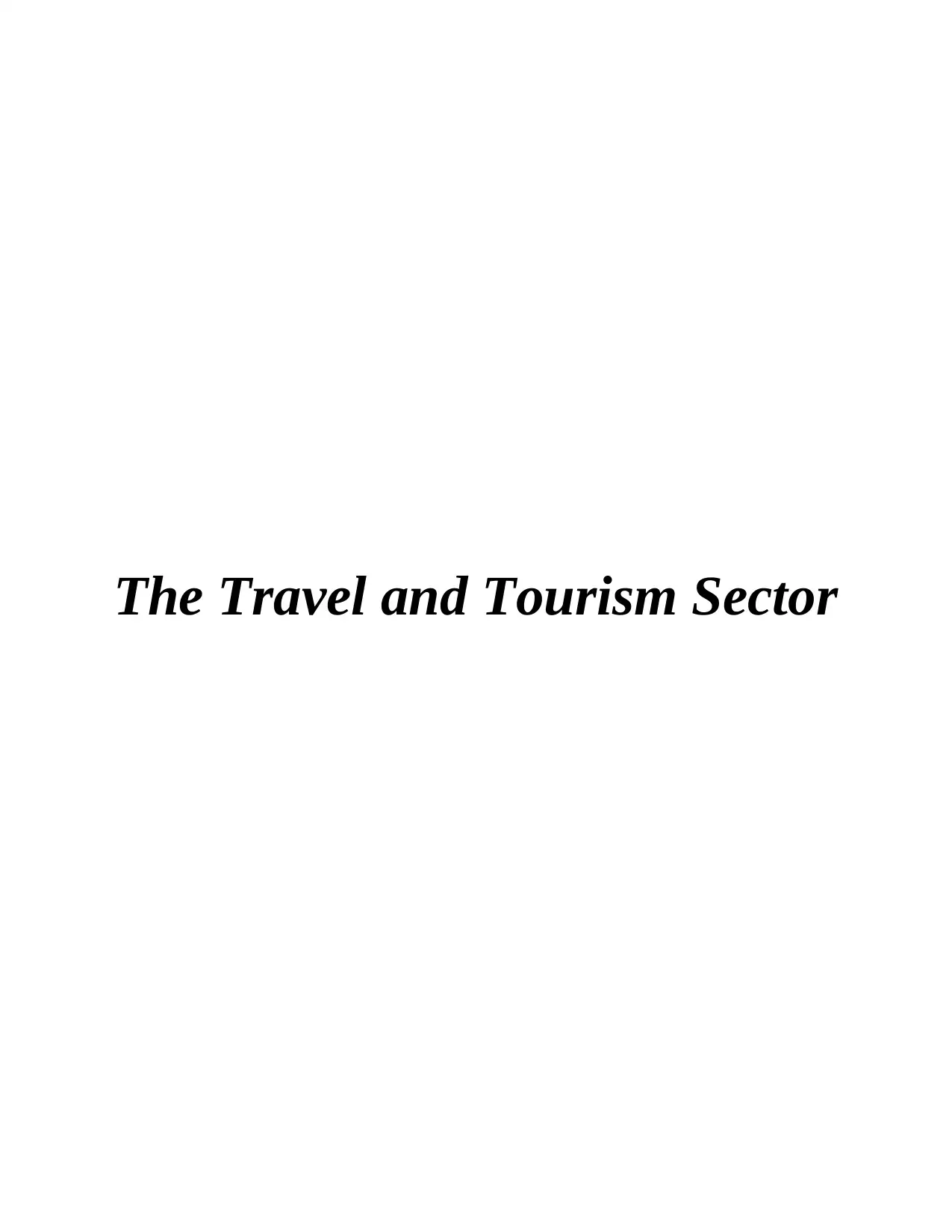
The Travel and Tourism Sector
Secure Best Marks with AI Grader
Need help grading? Try our AI Grader for instant feedback on your assignments.
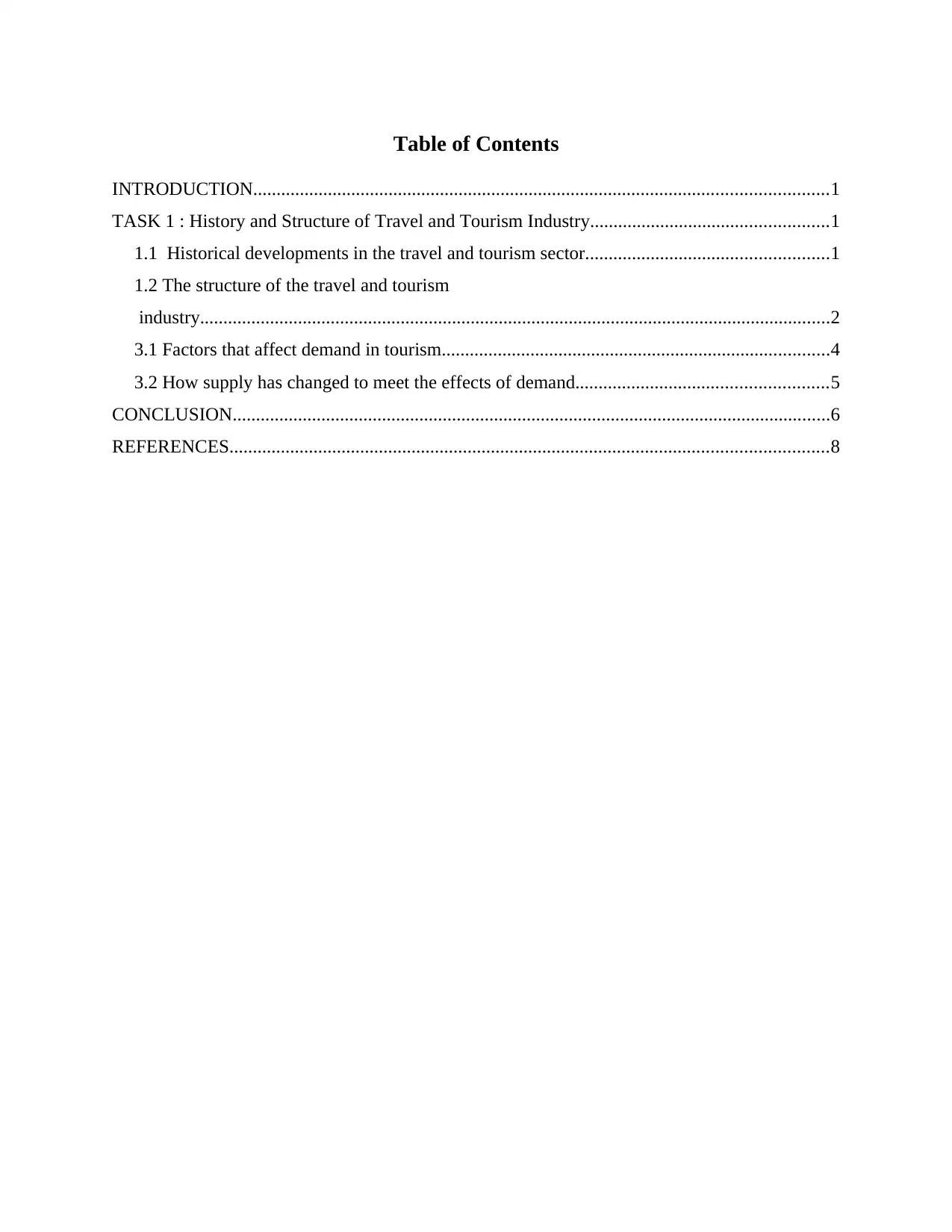
Table of Contents
INTRODUCTION...........................................................................................................................1
TASK 1 : History and Structure of Travel and Tourism Industry...................................................1
1.1 Historical developments in the travel and tourism sector....................................................1
1.2 The structure of the travel and tourism
industry.......................................................................................................................................2
3.1 Factors that affect demand in tourism...................................................................................4
3.2 How supply has changed to meet the effects of demand......................................................5
CONCLUSION................................................................................................................................6
REFERENCES................................................................................................................................8
INTRODUCTION...........................................................................................................................1
TASK 1 : History and Structure of Travel and Tourism Industry...................................................1
1.1 Historical developments in the travel and tourism sector....................................................1
1.2 The structure of the travel and tourism
industry.......................................................................................................................................2
3.1 Factors that affect demand in tourism...................................................................................4
3.2 How supply has changed to meet the effects of demand......................................................5
CONCLUSION................................................................................................................................6
REFERENCES................................................................................................................................8

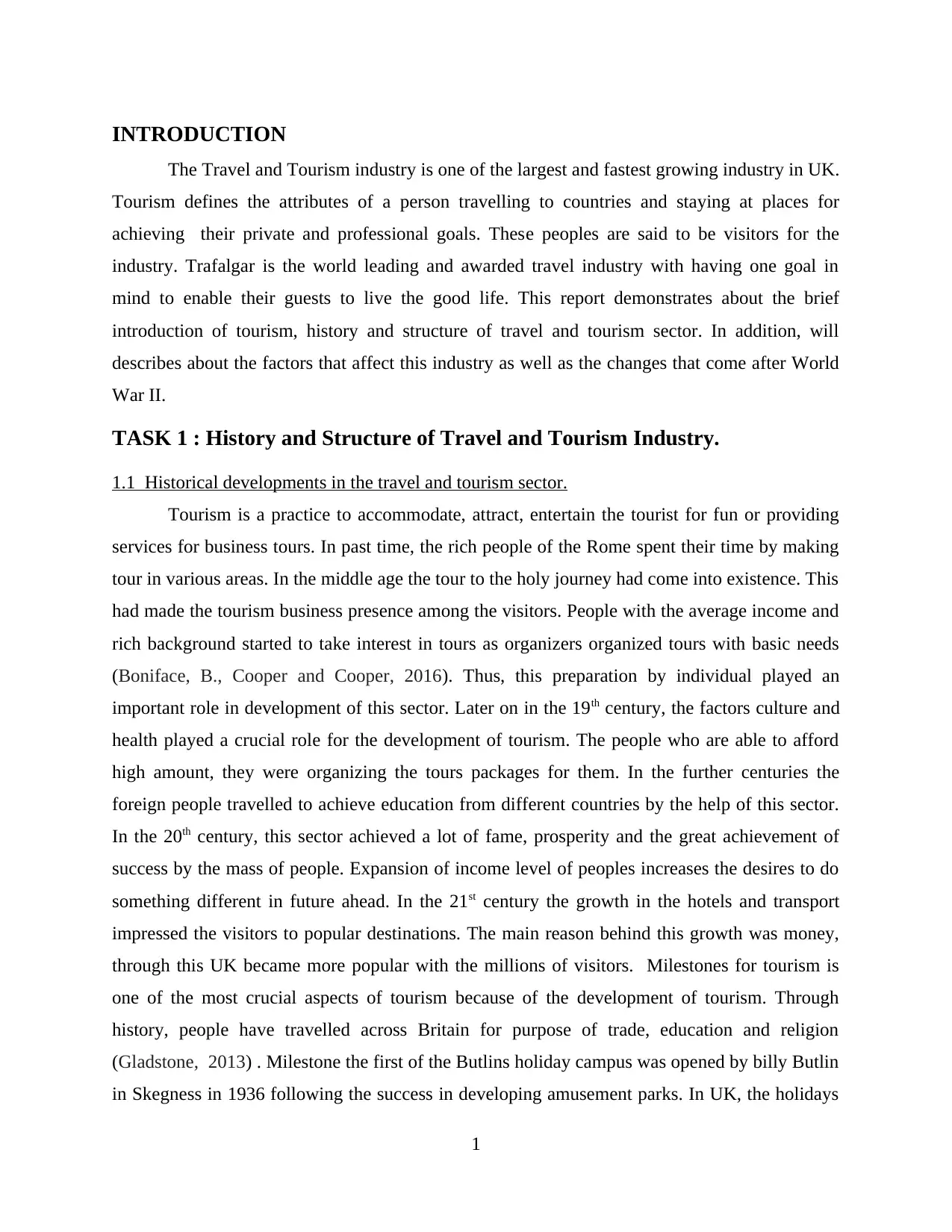
INTRODUCTION
The Travel and Tourism industry is one of the largest and fastest growing industry in UK.
Tourism defines the attributes of a person travelling to countries and staying at places for
achieving their private and professional goals. These peoples are said to be visitors for the
industry. Trafalgar is the world leading and awarded travel industry with having one goal in
mind to enable their guests to live the good life. This report demonstrates about the brief
introduction of tourism, history and structure of travel and tourism sector. In addition, will
describes about the factors that affect this industry as well as the changes that come after World
War II.
TASK 1 : History and Structure of Travel and Tourism Industry.
1.1 Historical developments in the travel and tourism sector.
Tourism is a practice to accommodate, attract, entertain the tourist for fun or providing
services for business tours. In past time, the rich people of the Rome spent their time by making
tour in various areas. In the middle age the tour to the holy journey had come into existence. This
had made the tourism business presence among the visitors. People with the average income and
rich background started to take interest in tours as organizers organized tours with basic needs
(Boniface, B., Cooper and Cooper, 2016). Thus, this preparation by individual played an
important role in development of this sector. Later on in the 19th century, the factors culture and
health played a crucial role for the development of tourism. The people who are able to afford
high amount, they were organizing the tours packages for them. In the further centuries the
foreign people travelled to achieve education from different countries by the help of this sector.
In the 20th century, this sector achieved a lot of fame, prosperity and the great achievement of
success by the mass of people. Expansion of income level of peoples increases the desires to do
something different in future ahead. In the 21st century the growth in the hotels and transport
impressed the visitors to popular destinations. The main reason behind this growth was money,
through this UK became more popular with the millions of visitors. Milestones for tourism is
one of the most crucial aspects of tourism because of the development of tourism. Through
history, people have travelled across Britain for purpose of trade, education and religion
(Gladstone, 2013) . Milestone the first of the Butlins holiday campus was opened by billy Butlin
in Skegness in 1936 following the success in developing amusement parks. In UK, the holidays
1
The Travel and Tourism industry is one of the largest and fastest growing industry in UK.
Tourism defines the attributes of a person travelling to countries and staying at places for
achieving their private and professional goals. These peoples are said to be visitors for the
industry. Trafalgar is the world leading and awarded travel industry with having one goal in
mind to enable their guests to live the good life. This report demonstrates about the brief
introduction of tourism, history and structure of travel and tourism sector. In addition, will
describes about the factors that affect this industry as well as the changes that come after World
War II.
TASK 1 : History and Structure of Travel and Tourism Industry.
1.1 Historical developments in the travel and tourism sector.
Tourism is a practice to accommodate, attract, entertain the tourist for fun or providing
services for business tours. In past time, the rich people of the Rome spent their time by making
tour in various areas. In the middle age the tour to the holy journey had come into existence. This
had made the tourism business presence among the visitors. People with the average income and
rich background started to take interest in tours as organizers organized tours with basic needs
(Boniface, B., Cooper and Cooper, 2016). Thus, this preparation by individual played an
important role in development of this sector. Later on in the 19th century, the factors culture and
health played a crucial role for the development of tourism. The people who are able to afford
high amount, they were organizing the tours packages for them. In the further centuries the
foreign people travelled to achieve education from different countries by the help of this sector.
In the 20th century, this sector achieved a lot of fame, prosperity and the great achievement of
success by the mass of people. Expansion of income level of peoples increases the desires to do
something different in future ahead. In the 21st century the growth in the hotels and transport
impressed the visitors to popular destinations. The main reason behind this growth was money,
through this UK became more popular with the millions of visitors. Milestones for tourism is
one of the most crucial aspects of tourism because of the development of tourism. Through
history, people have travelled across Britain for purpose of trade, education and religion
(Gladstone, 2013) . Milestone the first of the Butlins holiday campus was opened by billy Butlin
in Skegness in 1936 following the success in developing amusement parks. In UK, the holidays
1
Secure Best Marks with AI Grader
Need help grading? Try our AI Grader for instant feedback on your assignments.
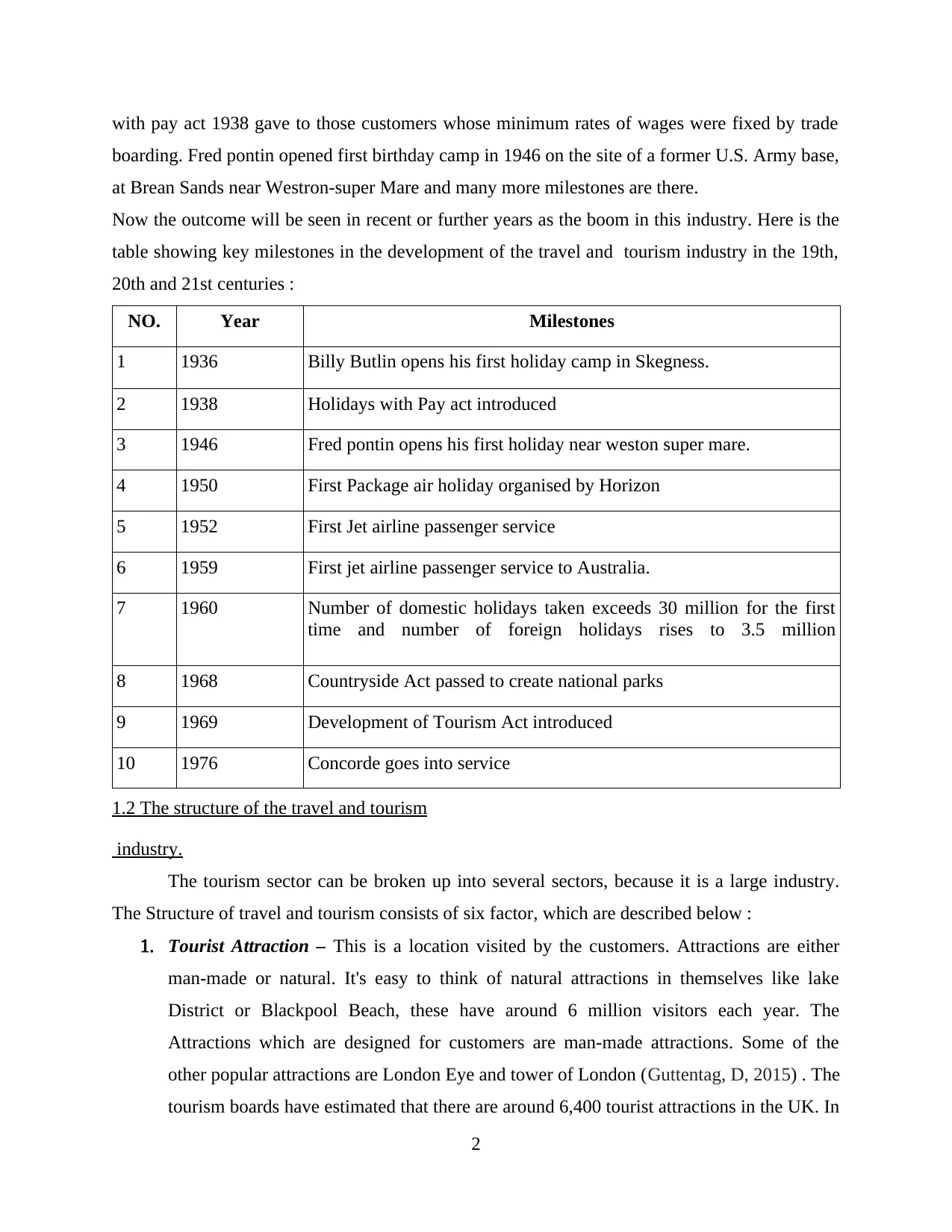
with pay act 1938 gave to those customers whose minimum rates of wages were fixed by trade
boarding. Fred pontin opened first birthday camp in 1946 on the site of a former U.S. Army base,
at Brean Sands near Westron-super Mare and many more milestones are there.
Now the outcome will be seen in recent or further years as the boom in this industry. Here is the
table showing key milestones in the development of the travel and tourism industry in the 19th,
20th and 21st centuries :
NO. Year Milestones
1 1936 Billy Butlin opens his first holiday camp in Skegness.
2 1938 Holidays with Pay act introduced
3 1946 Fred pontin opens his first holiday near weston super mare.
4 1950 First Package air holiday organised by Horizon
5 1952 First Jet airline passenger service
6 1959 First jet airline passenger service to Australia.
7 1960 Number of domestic holidays taken exceeds 30 million for the first
time and number of foreign holidays rises to 3.5 million
8 1968 Countryside Act passed to create national parks
9 1969 Development of Tourism Act introduced
10 1976 Concorde goes into service
1.2 The structure of the travel and tourism
industry.
The tourism sector can be broken up into several sectors, because it is a large industry.
The Structure of travel and tourism consists of six factor, which are described below :
1. Tourist Attraction – This is a location visited by the customers. Attractions are either
man-made or natural. It's easy to think of natural attractions in themselves like lake
District or Blackpool Beach, these have around 6 million visitors each year. The
Attractions which are designed for customers are man-made attractions. Some of the
other popular attractions are London Eye and tower of London (Guttentag, D, 2015) . The
tourism boards have estimated that there are around 6,400 tourist attractions in the UK. In
2
boarding. Fred pontin opened first birthday camp in 1946 on the site of a former U.S. Army base,
at Brean Sands near Westron-super Mare and many more milestones are there.
Now the outcome will be seen in recent or further years as the boom in this industry. Here is the
table showing key milestones in the development of the travel and tourism industry in the 19th,
20th and 21st centuries :
NO. Year Milestones
1 1936 Billy Butlin opens his first holiday camp in Skegness.
2 1938 Holidays with Pay act introduced
3 1946 Fred pontin opens his first holiday near weston super mare.
4 1950 First Package air holiday organised by Horizon
5 1952 First Jet airline passenger service
6 1959 First jet airline passenger service to Australia.
7 1960 Number of domestic holidays taken exceeds 30 million for the first
time and number of foreign holidays rises to 3.5 million
8 1968 Countryside Act passed to create national parks
9 1969 Development of Tourism Act introduced
10 1976 Concorde goes into service
1.2 The structure of the travel and tourism
industry.
The tourism sector can be broken up into several sectors, because it is a large industry.
The Structure of travel and tourism consists of six factor, which are described below :
1. Tourist Attraction – This is a location visited by the customers. Attractions are either
man-made or natural. It's easy to think of natural attractions in themselves like lake
District or Blackpool Beach, these have around 6 million visitors each year. The
Attractions which are designed for customers are man-made attractions. Some of the
other popular attractions are London Eye and tower of London (Guttentag, D, 2015) . The
tourism boards have estimated that there are around 6,400 tourist attractions in the UK. In
2
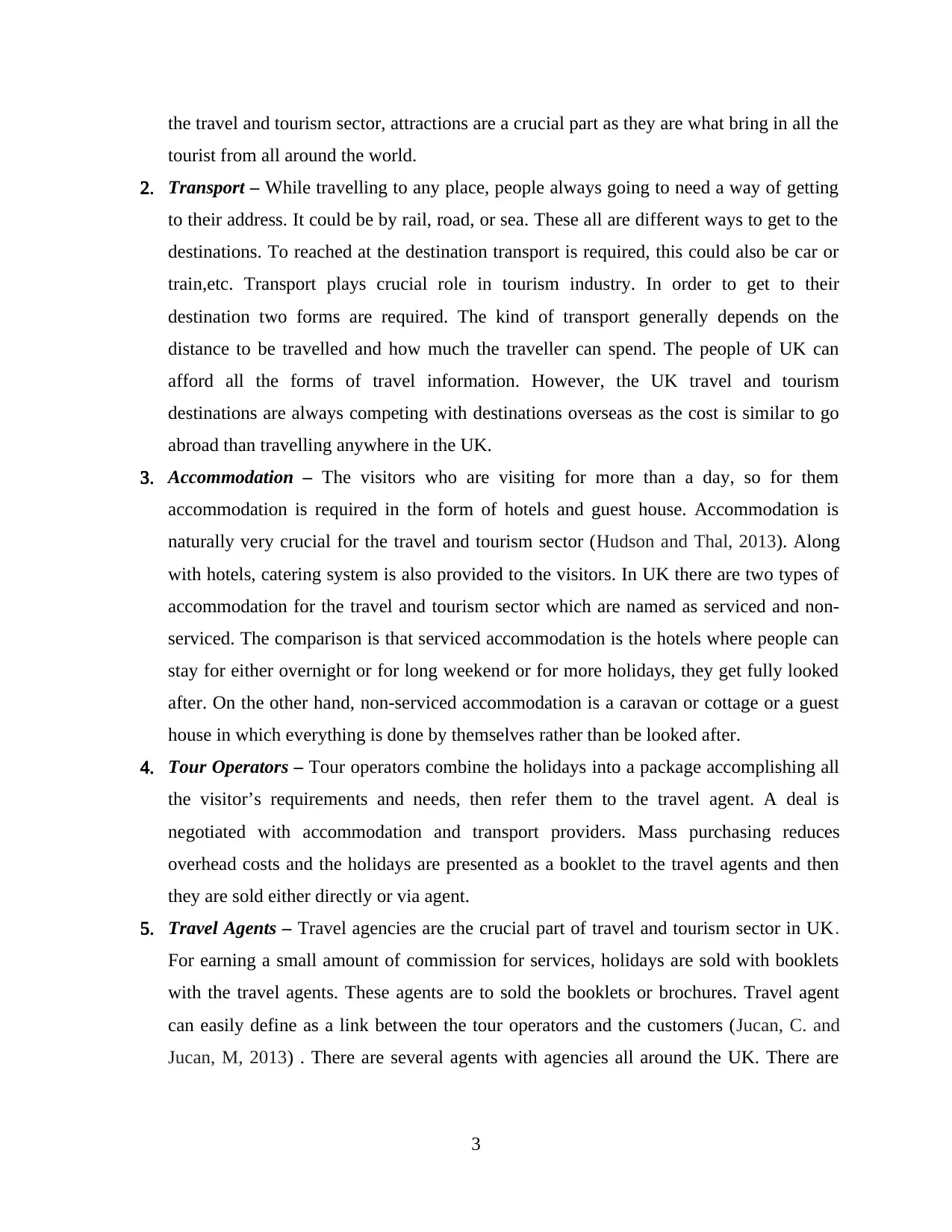
the travel and tourism sector, attractions are a crucial part as they are what bring in all the
tourist from all around the world.
2. Transport – While travelling to any place, people always going to need a way of getting
to their address. It could be by rail, road, or sea. These all are different ways to get to the
destinations. To reached at the destination transport is required, this could also be car or
train,etc. Transport plays crucial role in tourism industry. In order to get to their
destination two forms are required. The kind of transport generally depends on the
distance to be travelled and how much the traveller can spend. The people of UK can
afford all the forms of travel information. However, the UK travel and tourism
destinations are always competing with destinations overseas as the cost is similar to go
abroad than travelling anywhere in the UK.
3. Accommodation – The visitors who are visiting for more than a day, so for them
accommodation is required in the form of hotels and guest house. Accommodation is
naturally very crucial for the travel and tourism sector (Hudson and Thal, 2013). Along
with hotels, catering system is also provided to the visitors. In UK there are two types of
accommodation for the travel and tourism sector which are named as serviced and non-
serviced. The comparison is that serviced accommodation is the hotels where people can
stay for either overnight or for long weekend or for more holidays, they get fully looked
after. On the other hand, non-serviced accommodation is a caravan or cottage or a guest
house in which everything is done by themselves rather than be looked after.
4. Tour Operators – Tour operators combine the holidays into a package accomplishing all
the visitor’s requirements and needs, then refer them to the travel agent. A deal is
negotiated with accommodation and transport providers. Mass purchasing reduces
overhead costs and the holidays are presented as a booklet to the travel agents and then
they are sold either directly or via agent.
5. Travel Agents – Travel agencies are the crucial part of travel and tourism sector in UK.
For earning a small amount of commission for services, holidays are sold with booklets
with the travel agents. These agents are to sold the booklets or brochures. Travel agent
can easily define as a link between the tour operators and the customers (Jucan, C. and
Jucan, M, 2013) . There are several agents with agencies all around the UK. There are
3
tourist from all around the world.
2. Transport – While travelling to any place, people always going to need a way of getting
to their address. It could be by rail, road, or sea. These all are different ways to get to the
destinations. To reached at the destination transport is required, this could also be car or
train,etc. Transport plays crucial role in tourism industry. In order to get to their
destination two forms are required. The kind of transport generally depends on the
distance to be travelled and how much the traveller can spend. The people of UK can
afford all the forms of travel information. However, the UK travel and tourism
destinations are always competing with destinations overseas as the cost is similar to go
abroad than travelling anywhere in the UK.
3. Accommodation – The visitors who are visiting for more than a day, so for them
accommodation is required in the form of hotels and guest house. Accommodation is
naturally very crucial for the travel and tourism sector (Hudson and Thal, 2013). Along
with hotels, catering system is also provided to the visitors. In UK there are two types of
accommodation for the travel and tourism sector which are named as serviced and non-
serviced. The comparison is that serviced accommodation is the hotels where people can
stay for either overnight or for long weekend or for more holidays, they get fully looked
after. On the other hand, non-serviced accommodation is a caravan or cottage or a guest
house in which everything is done by themselves rather than be looked after.
4. Tour Operators – Tour operators combine the holidays into a package accomplishing all
the visitor’s requirements and needs, then refer them to the travel agent. A deal is
negotiated with accommodation and transport providers. Mass purchasing reduces
overhead costs and the holidays are presented as a booklet to the travel agents and then
they are sold either directly or via agent.
5. Travel Agents – Travel agencies are the crucial part of travel and tourism sector in UK.
For earning a small amount of commission for services, holidays are sold with booklets
with the travel agents. These agents are to sold the booklets or brochures. Travel agent
can easily define as a link between the tour operators and the customers (Jucan, C. and
Jucan, M, 2013) . There are several agents with agencies all around the UK. There are
3
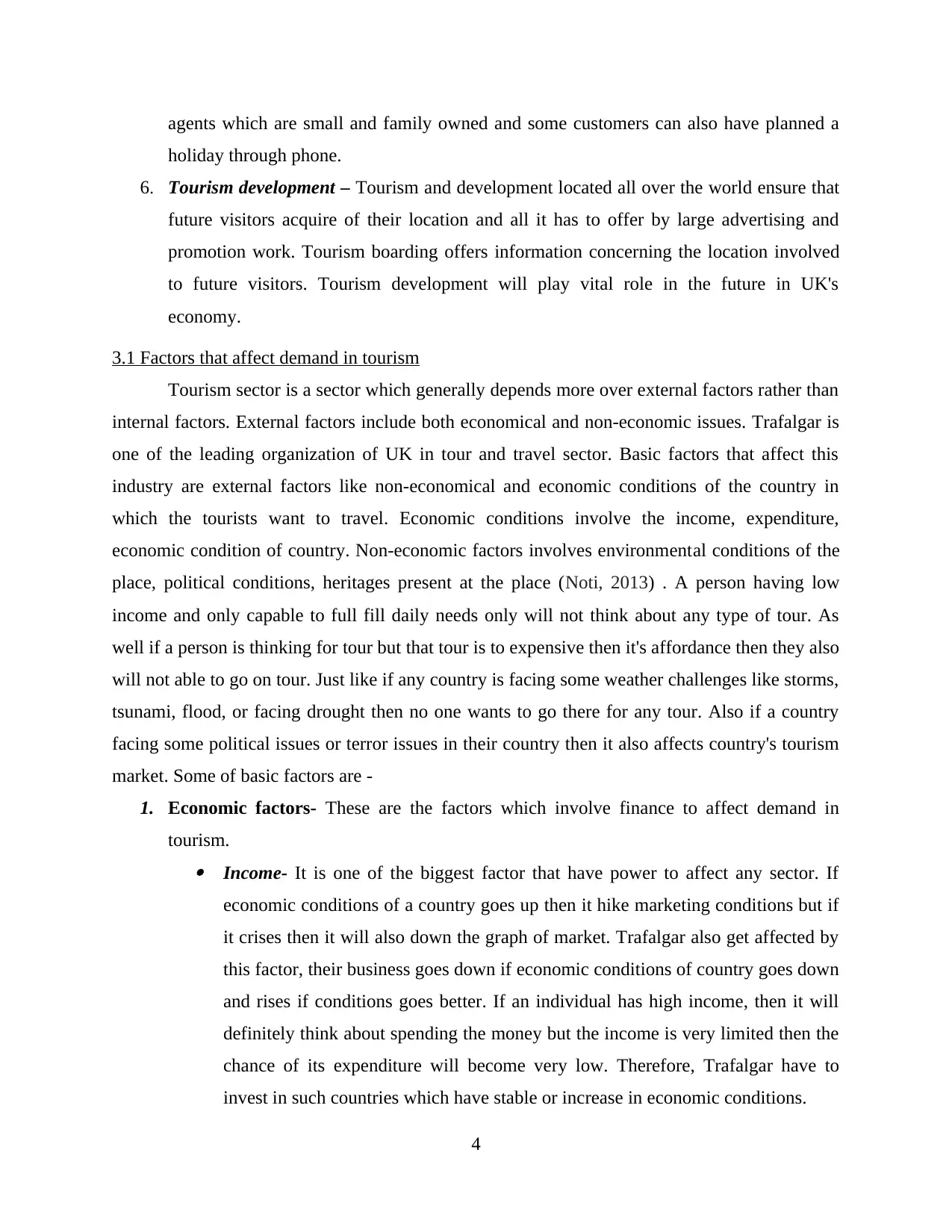
agents which are small and family owned and some customers can also have planned a
holiday through phone.
6. Tourism development – Tourism and development located all over the world ensure that
future visitors acquire of their location and all it has to offer by large advertising and
promotion work. Tourism boarding offers information concerning the location involved
to future visitors. Tourism development will play vital role in the future in UK's
economy.
3.1 Factors that affect demand in tourism
Tourism sector is a sector which generally depends more over external factors rather than
internal factors. External factors include both economical and non-economic issues. Trafalgar is
one of the leading organization of UK in tour and travel sector. Basic factors that affect this
industry are external factors like non-economical and economic conditions of the country in
which the tourists want to travel. Economic conditions involve the income, expenditure,
economic condition of country. Non-economic factors involves environmental conditions of the
place, political conditions, heritages present at the place (Noti, 2013) . A person having low
income and only capable to full fill daily needs only will not think about any type of tour. As
well if a person is thinking for tour but that tour is to expensive then it's affordance then they also
will not able to go on tour. Just like if any country is facing some weather challenges like storms,
tsunami, flood, or facing drought then no one wants to go there for any tour. Also if a country
facing some political issues or terror issues in their country then it also affects country's tourism
market. Some of basic factors are -
1. Economic factors- These are the factors which involve finance to affect demand in
tourism.
Income- It is one of the biggest factor that have power to affect any sector. If
economic conditions of a country goes up then it hike marketing conditions but if
it crises then it will also down the graph of market. Trafalgar also get affected by
this factor, their business goes down if economic conditions of country goes down
and rises if conditions goes better. If an individual has high income, then it will
definitely think about spending the money but the income is very limited then the
chance of its expenditure will become very low. Therefore, Trafalgar have to
invest in such countries which have stable or increase in economic conditions.
4
holiday through phone.
6. Tourism development – Tourism and development located all over the world ensure that
future visitors acquire of their location and all it has to offer by large advertising and
promotion work. Tourism boarding offers information concerning the location involved
to future visitors. Tourism development will play vital role in the future in UK's
economy.
3.1 Factors that affect demand in tourism
Tourism sector is a sector which generally depends more over external factors rather than
internal factors. External factors include both economical and non-economic issues. Trafalgar is
one of the leading organization of UK in tour and travel sector. Basic factors that affect this
industry are external factors like non-economical and economic conditions of the country in
which the tourists want to travel. Economic conditions involve the income, expenditure,
economic condition of country. Non-economic factors involves environmental conditions of the
place, political conditions, heritages present at the place (Noti, 2013) . A person having low
income and only capable to full fill daily needs only will not think about any type of tour. As
well if a person is thinking for tour but that tour is to expensive then it's affordance then they also
will not able to go on tour. Just like if any country is facing some weather challenges like storms,
tsunami, flood, or facing drought then no one wants to go there for any tour. Also if a country
facing some political issues or terror issues in their country then it also affects country's tourism
market. Some of basic factors are -
1. Economic factors- These are the factors which involve finance to affect demand in
tourism.
Income- It is one of the biggest factor that have power to affect any sector. If
economic conditions of a country goes up then it hike marketing conditions but if
it crises then it will also down the graph of market. Trafalgar also get affected by
this factor, their business goes down if economic conditions of country goes down
and rises if conditions goes better. If an individual has high income, then it will
definitely think about spending the money but the income is very limited then the
chance of its expenditure will become very low. Therefore, Trafalgar have to
invest in such countries which have stable or increase in economic conditions.
4
Paraphrase This Document
Need a fresh take? Get an instant paraphrase of this document with our AI Paraphraser
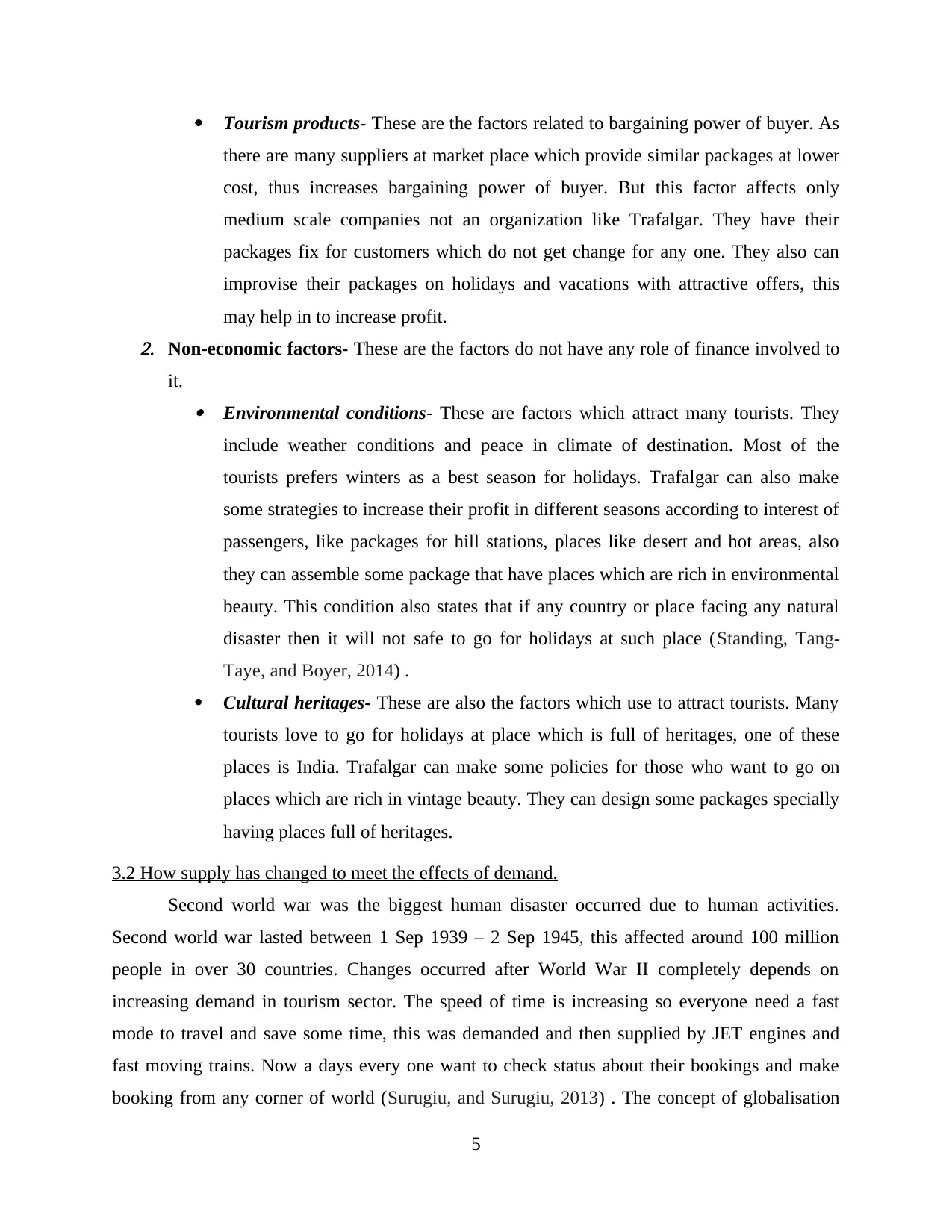
Tourism products- These are the factors related to bargaining power of buyer. As
there are many suppliers at market place which provide similar packages at lower
cost, thus increases bargaining power of buyer. But this factor affects only
medium scale companies not an organization like Trafalgar. They have their
packages fix for customers which do not get change for any one. They also can
improvise their packages on holidays and vacations with attractive offers, this
may help in to increase profit.2. Non-economic factors- These are the factors do not have any role of finance involved to
it.
Environmental conditions- These are factors which attract many tourists. They
include weather conditions and peace in climate of destination. Most of the
tourists prefers winters as a best season for holidays. Trafalgar can also make
some strategies to increase their profit in different seasons according to interest of
passengers, like packages for hill stations, places like desert and hot areas, also
they can assemble some package that have places which are rich in environmental
beauty. This condition also states that if any country or place facing any natural
disaster then it will not safe to go for holidays at such place (Standing, Tang-
Taye, and Boyer, 2014) .
Cultural heritages- These are also the factors which use to attract tourists. Many
tourists love to go for holidays at place which is full of heritages, one of these
places is India. Trafalgar can make some policies for those who want to go on
places which are rich in vintage beauty. They can design some packages specially
having places full of heritages.
3.2 How supply has changed to meet the effects of demand.
Second world war was the biggest human disaster occurred due to human activities.
Second world war lasted between 1 Sep 1939 – 2 Sep 1945, this affected around 100 million
people in over 30 countries. Changes occurred after World War II completely depends on
increasing demand in tourism sector. The speed of time is increasing so everyone need a fast
mode to travel and save some time, this was demanded and then supplied by JET engines and
fast moving trains. Now a days every one want to check status about their bookings and make
booking from any corner of world (Surugiu, and Surugiu, 2013) . The concept of globalisation
5
there are many suppliers at market place which provide similar packages at lower
cost, thus increases bargaining power of buyer. But this factor affects only
medium scale companies not an organization like Trafalgar. They have their
packages fix for customers which do not get change for any one. They also can
improvise their packages on holidays and vacations with attractive offers, this
may help in to increase profit.2. Non-economic factors- These are the factors do not have any role of finance involved to
it.
Environmental conditions- These are factors which attract many tourists. They
include weather conditions and peace in climate of destination. Most of the
tourists prefers winters as a best season for holidays. Trafalgar can also make
some strategies to increase their profit in different seasons according to interest of
passengers, like packages for hill stations, places like desert and hot areas, also
they can assemble some package that have places which are rich in environmental
beauty. This condition also states that if any country or place facing any natural
disaster then it will not safe to go for holidays at such place (Standing, Tang-
Taye, and Boyer, 2014) .
Cultural heritages- These are also the factors which use to attract tourists. Many
tourists love to go for holidays at place which is full of heritages, one of these
places is India. Trafalgar can make some policies for those who want to go on
places which are rich in vintage beauty. They can design some packages specially
having places full of heritages.
3.2 How supply has changed to meet the effects of demand.
Second world war was the biggest human disaster occurred due to human activities.
Second world war lasted between 1 Sep 1939 – 2 Sep 1945, this affected around 100 million
people in over 30 countries. Changes occurred after World War II completely depends on
increasing demand in tourism sector. The speed of time is increasing so everyone need a fast
mode to travel and save some time, this was demanded and then supplied by JET engines and
fast moving trains. Now a days every one want to check status about their bookings and make
booking from any corner of world (Surugiu, and Surugiu, 2013) . The concept of globalisation
5
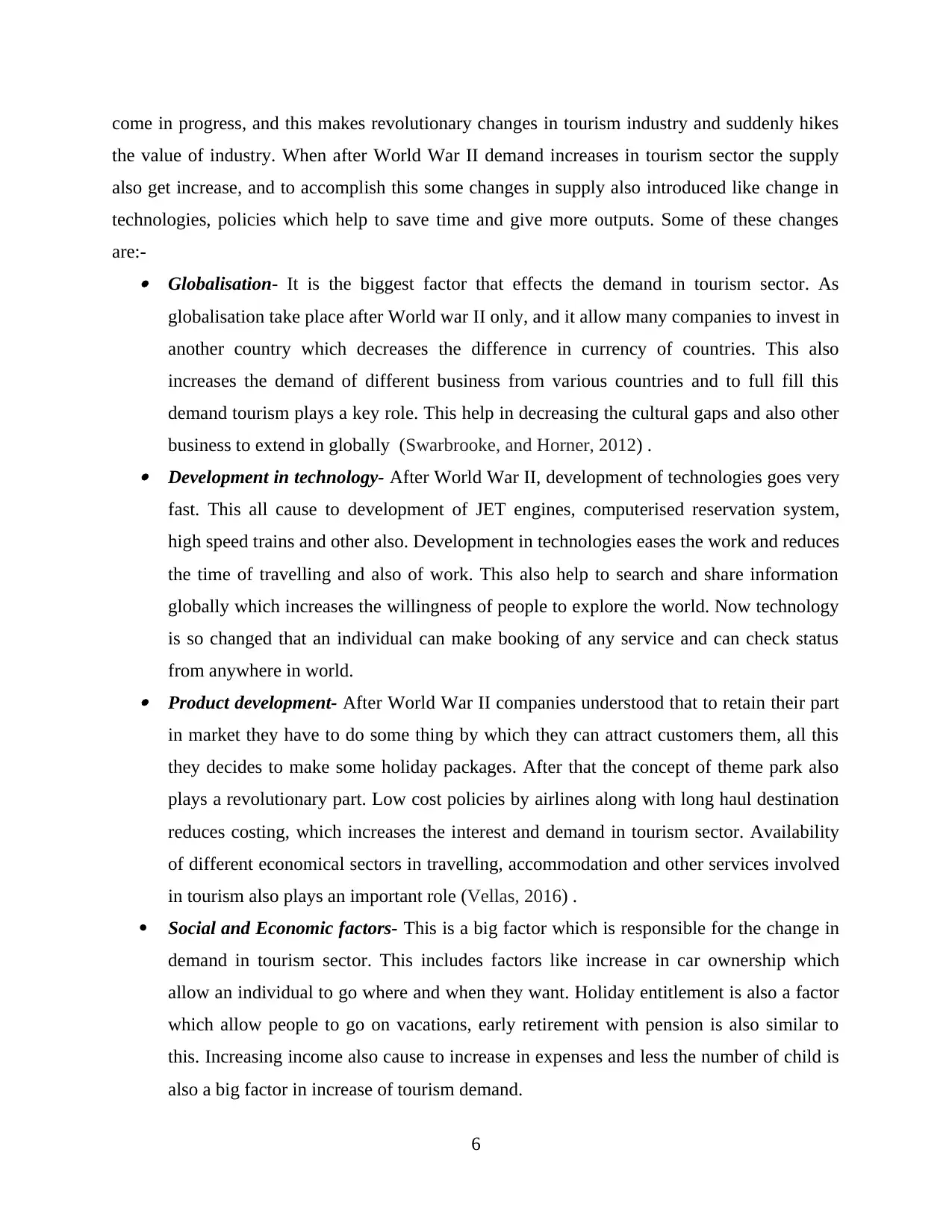
come in progress, and this makes revolutionary changes in tourism industry and suddenly hikes
the value of industry. When after World War II demand increases in tourism sector the supply
also get increase, and to accomplish this some changes in supply also introduced like change in
technologies, policies which help to save time and give more outputs. Some of these changes
are:- Globalisation- It is the biggest factor that effects the demand in tourism sector. As
globalisation take place after World war II only, and it allow many companies to invest in
another country which decreases the difference in currency of countries. This also
increases the demand of different business from various countries and to full fill this
demand tourism plays a key role. This help in decreasing the cultural gaps and also other
business to extend in globally (Swarbrooke, and Horner, 2012) . Development in technology- After World War II, development of technologies goes very
fast. This all cause to development of JET engines, computerised reservation system,
high speed trains and other also. Development in technologies eases the work and reduces
the time of travelling and also of work. This also help to search and share information
globally which increases the willingness of people to explore the world. Now technology
is so changed that an individual can make booking of any service and can check status
from anywhere in world. Product development- After World War II companies understood that to retain their part
in market they have to do some thing by which they can attract customers them, all this
they decides to make some holiday packages. After that the concept of theme park also
plays a revolutionary part. Low cost policies by airlines along with long haul destination
reduces costing, which increases the interest and demand in tourism sector. Availability
of different economical sectors in travelling, accommodation and other services involved
in tourism also plays an important role (Vellas, 2016) .
Social and Economic factors- This is a big factor which is responsible for the change in
demand in tourism sector. This includes factors like increase in car ownership which
allow an individual to go where and when they want. Holiday entitlement is also a factor
which allow people to go on vacations, early retirement with pension is also similar to
this. Increasing income also cause to increase in expenses and less the number of child is
also a big factor in increase of tourism demand.
6
the value of industry. When after World War II demand increases in tourism sector the supply
also get increase, and to accomplish this some changes in supply also introduced like change in
technologies, policies which help to save time and give more outputs. Some of these changes
are:- Globalisation- It is the biggest factor that effects the demand in tourism sector. As
globalisation take place after World war II only, and it allow many companies to invest in
another country which decreases the difference in currency of countries. This also
increases the demand of different business from various countries and to full fill this
demand tourism plays a key role. This help in decreasing the cultural gaps and also other
business to extend in globally (Swarbrooke, and Horner, 2012) . Development in technology- After World War II, development of technologies goes very
fast. This all cause to development of JET engines, computerised reservation system,
high speed trains and other also. Development in technologies eases the work and reduces
the time of travelling and also of work. This also help to search and share information
globally which increases the willingness of people to explore the world. Now technology
is so changed that an individual can make booking of any service and can check status
from anywhere in world. Product development- After World War II companies understood that to retain their part
in market they have to do some thing by which they can attract customers them, all this
they decides to make some holiday packages. After that the concept of theme park also
plays a revolutionary part. Low cost policies by airlines along with long haul destination
reduces costing, which increases the interest and demand in tourism sector. Availability
of different economical sectors in travelling, accommodation and other services involved
in tourism also plays an important role (Vellas, 2016) .
Social and Economic factors- This is a big factor which is responsible for the change in
demand in tourism sector. This includes factors like increase in car ownership which
allow an individual to go where and when they want. Holiday entitlement is also a factor
which allow people to go on vacations, early retirement with pension is also similar to
this. Increasing income also cause to increase in expenses and less the number of child is
also a big factor in increase of tourism demand.
6
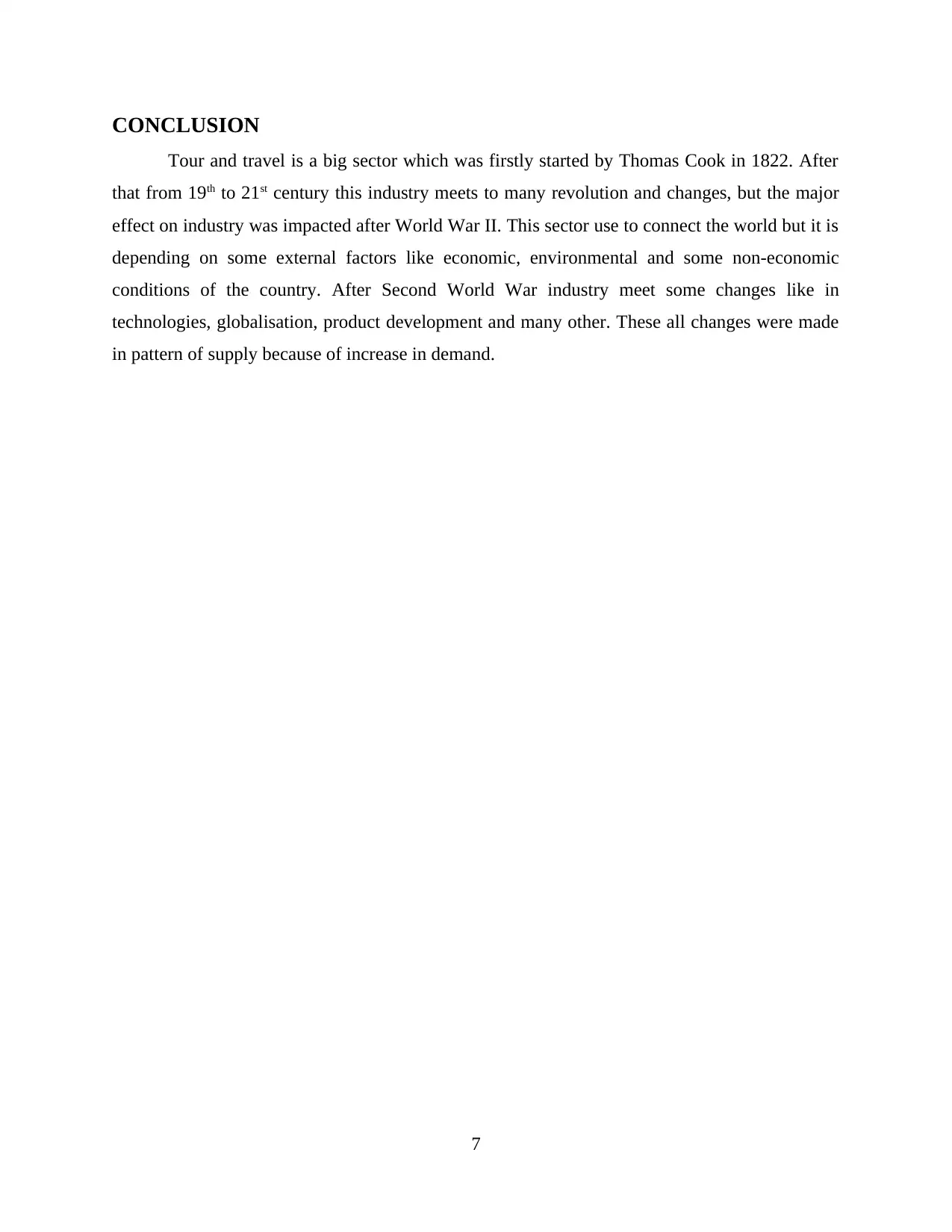
CONCLUSION
Tour and travel is a big sector which was firstly started by Thomas Cook in 1822. After
that from 19th to 21st century this industry meets to many revolution and changes, but the major
effect on industry was impacted after World War II. This sector use to connect the world but it is
depending on some external factors like economic, environmental and some non-economic
conditions of the country. After Second World War industry meet some changes like in
technologies, globalisation, product development and many other. These all changes were made
in pattern of supply because of increase in demand.
7
Tour and travel is a big sector which was firstly started by Thomas Cook in 1822. After
that from 19th to 21st century this industry meets to many revolution and changes, but the major
effect on industry was impacted after World War II. This sector use to connect the world but it is
depending on some external factors like economic, environmental and some non-economic
conditions of the country. After Second World War industry meet some changes like in
technologies, globalisation, product development and many other. These all changes were made
in pattern of supply because of increase in demand.
7
Secure Best Marks with AI Grader
Need help grading? Try our AI Grader for instant feedback on your assignments.
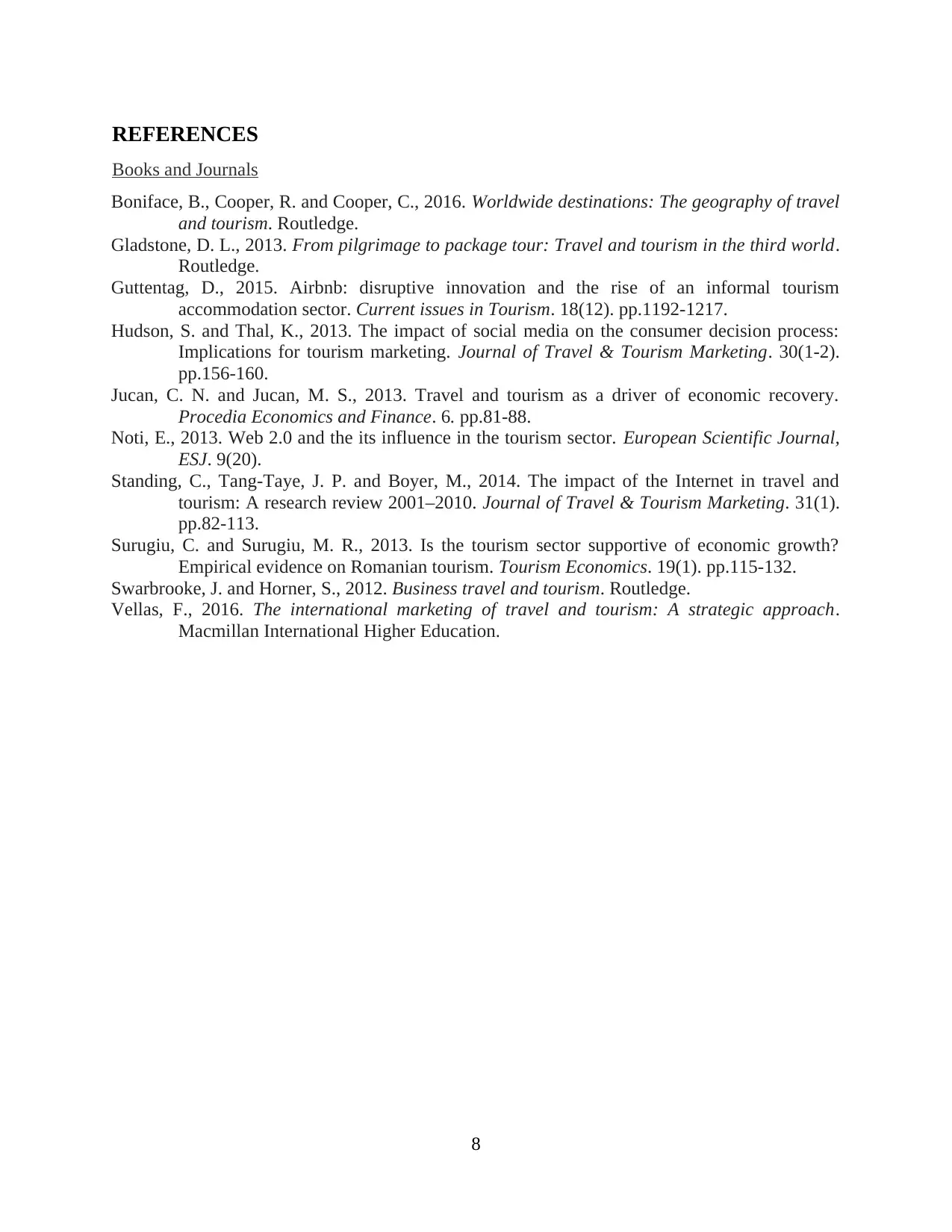
REFERENCES
Books and Journals
Boniface, B., Cooper, R. and Cooper, C., 2016. Worldwide destinations: The geography of travel
and tourism. Routledge.
Gladstone, D. L., 2013. From pilgrimage to package tour: Travel and tourism in the third world.
Routledge.
Guttentag, D., 2015. Airbnb: disruptive innovation and the rise of an informal tourism
accommodation sector. Current issues in Tourism. 18(12). pp.1192-1217.
Hudson, S. and Thal, K., 2013. The impact of social media on the consumer decision process:
Implications for tourism marketing. Journal of Travel & Tourism Marketing. 30(1-2).
pp.156-160.
Jucan, C. N. and Jucan, M. S., 2013. Travel and tourism as a driver of economic recovery.
Procedia Economics and Finance. 6. pp.81-88.
Noti, E., 2013. Web 2.0 and the its influence in the tourism sector. European Scientific Journal,
ESJ. 9(20).
Standing, C., Tang-Taye, J. P. and Boyer, M., 2014. The impact of the Internet in travel and
tourism: A research review 2001–2010. Journal of Travel & Tourism Marketing. 31(1).
pp.82-113.
Surugiu, C. and Surugiu, M. R., 2013. Is the tourism sector supportive of economic growth?
Empirical evidence on Romanian tourism. Tourism Economics. 19(1). pp.115-132.
Swarbrooke, J. and Horner, S., 2012. Business travel and tourism. Routledge.
Vellas, F., 2016. The international marketing of travel and tourism: A strategic approach.
Macmillan International Higher Education.
8
Books and Journals
Boniface, B., Cooper, R. and Cooper, C., 2016. Worldwide destinations: The geography of travel
and tourism. Routledge.
Gladstone, D. L., 2013. From pilgrimage to package tour: Travel and tourism in the third world.
Routledge.
Guttentag, D., 2015. Airbnb: disruptive innovation and the rise of an informal tourism
accommodation sector. Current issues in Tourism. 18(12). pp.1192-1217.
Hudson, S. and Thal, K., 2013. The impact of social media on the consumer decision process:
Implications for tourism marketing. Journal of Travel & Tourism Marketing. 30(1-2).
pp.156-160.
Jucan, C. N. and Jucan, M. S., 2013. Travel and tourism as a driver of economic recovery.
Procedia Economics and Finance. 6. pp.81-88.
Noti, E., 2013. Web 2.0 and the its influence in the tourism sector. European Scientific Journal,
ESJ. 9(20).
Standing, C., Tang-Taye, J. P. and Boyer, M., 2014. The impact of the Internet in travel and
tourism: A research review 2001–2010. Journal of Travel & Tourism Marketing. 31(1).
pp.82-113.
Surugiu, C. and Surugiu, M. R., 2013. Is the tourism sector supportive of economic growth?
Empirical evidence on Romanian tourism. Tourism Economics. 19(1). pp.115-132.
Swarbrooke, J. and Horner, S., 2012. Business travel and tourism. Routledge.
Vellas, F., 2016. The international marketing of travel and tourism: A strategic approach.
Macmillan International Higher Education.
8
1 out of 11
Related Documents
Your All-in-One AI-Powered Toolkit for Academic Success.
+13062052269
info@desklib.com
Available 24*7 on WhatsApp / Email
![[object Object]](/_next/static/media/star-bottom.7253800d.svg)
Unlock your academic potential
© 2024 | Zucol Services PVT LTD | All rights reserved.





